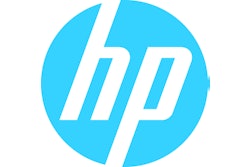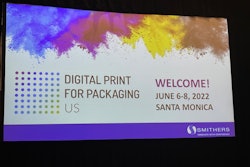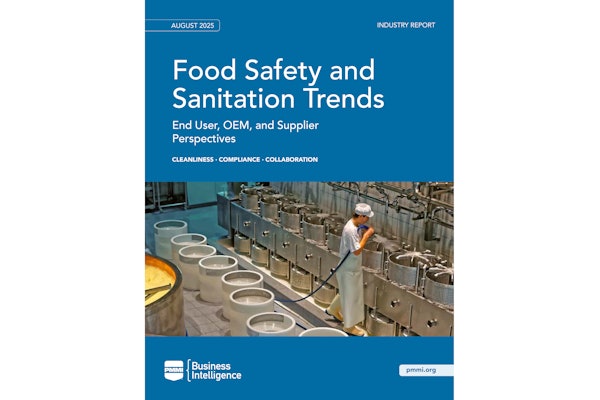Quick hits:
- The hospitality industry is increasingly being asked to provide more sustainable alternatives for body soap, shampoo, lotion, conditioner, etc., instead of single-use plastics.
- Personal care brand Public Goods offers hotels 12-oz. reusable bioplastic bottles that can be refilled by housekeeping with 32-oz. refill pouches.
- About 90% of the bottle’s material is bioplastic polyethylene (PE), produced using sugarcane instead of fossil fuels.
- Not only is non-renewable fossil fuel-based PE plastic avoided in favor of a renewable source, but sugarcane itself is carbon-neutral since it sequesters (stores) carbon while it’s in plant form.
- Brands do not realize the sustainability benefits digital printing has to offer.
- A recent study shows just how much waste digital printing eliminates.
- Digital printing quality has increased exponentially within the last decade
- Naturally Done: Bio-Based Blister Packs, Produce Nanofilm, and CBD-Based Packaging
- Sustainable Bio-Based Tray Made in the USA
- Digital Print for Packaging Website
- Conference Report: Digital Print’s Potential to Boost Sustainability
 | Read the transcript below: |
Matt Reynolds: Hello, I’m Matt Reynolds, editor of Packaging World, back with another edition of Take Five.
As with most consumer-facing markets today, the hotel industry is being challenged to meet guests’ increasing demand for more sustainable lodging. According to a 2021 study from Statista, 81% of travelers surveyed said they plan to choose a sustainable accommodation option in the coming year, and that percentage that has grown consistently over the past six years.
That’s where the CPG brand Public Goods comes in. It’s a producer of sustainable personal care products for hotels, among other markets, and its leadership saw an opportunity to offer sustainably packaged shampoo, conditioner, body wash, hand soap, moisturizer, and lotion to the hospitality industry.
One step Public Goods has taken has been partnering with Eden Reforestation Projects to plant a tree for every order, but packaging also plays a key role in the offering.
The typical pack format is a white bullet-round bottle with a black cap or dispensing pump. The refillable 12-oz containers are high-density polyethylene, and about 90% of that comes from Braskem’s “I’m Green” sugarcane-based PE. The company also offers a number of products in 3-oz travel-size bottles, also made from Braskem’s bioplastic.
The benefit of sugarcane-based plastics is that it doesn’t require petroleum to produce, so it doesn’t support the petroleum industry. Also, Braskem says production of sugarcane plastic is actually carbon neutral since the production of the sugarcane used as the raw material removes carbon from the atmosphere and sequesters it or stores it in plant form.
The package’s caps are made from virgin polypropylene, but the brand says its working on transitioning all of its plastic componentry to post-consumer recycled material, or PCR. And that switch applies to the bottles as well. When Public Goods first sought “greener” packaging in which to launch its products, it considered both bioplastics and PCR plastic. But PCR was hard to come by back then. That’s changed recently, and the Public Goods is seeking to move into more readily available PCR instead of introducing new plastic into the circular economy, even if it’s comparatively eco-friendly bioplastic.
Refills for personal care products come in a 34-oz flexible pouch. The decision to go with the non-recyclable material was a tough one, but given plastic’s poor recycling rate of 8.7%,
Public Goods felt it was wiser to prioritize reducing the amount of plastic it used. On a per-ounce basis of liquid product, the refillable plastic bottles use 5.4-times more plastic than the refills.
So who’s benefitting from Public Goods more sustainable hotel-focused offerings? One example is the Hero Beach Club hotel in Montauk, N.Y.
Until recently, the hotel was using single-use, disposable packaging for its hotel toiletries, which resulted in more waste and more work for hotel staff. For the sake of economics and the environment, Hero Beach Club switched to Public Goods’ toiletries in the 12-oz refillable bottles made from bioplastic we just discussed.
Following the departure of each guest, housekeeping staff tops the bottles off with product from 32-oz bulk refills—a process that is mess-free and spill-free, according to the hotel. And just to ensure the bottles are safe and clean for the next guest, housekeeping wipes down and sanitizes them.
Shifting gears, let’s hear from Melissa Griffen, reporting what’s new in digital printing for packaging.
Melissa Griffen: Hi, I’m Melissa Griffen, Contributing Editor for Packaging World magazine. At the Digital Print for Packaging US conference organized by Smithers and held a few weeks ago, industry experts outlined the sustainability benefits digital printing has to offer.
A panel of four brands at the conference showed that there is a misconception about digital printing’s sustainable value and many brands think the technology’s applications are limited to sales samples and personalization, in regional events for instance. They did not realize digital printing can help CPG companies reach their sustainability goals.
Throughout the conference, various speakers explained the technology’s sustainable value, including how it:
- doesn’t require cylinders or plates
- has less setup waste
- solves the obsolescence issues surrounding inventory as printing is on-demand
- increases speed-to-market
- and allows packaging consolidation for D2C packaging
Doris Brown-McNally, WW brands innovation & strategic partner manager at HP Inc., shared that her company had recently done a study with One Tribe, a certified B Corp. made up of environmentalists, technologists, and marketers who help brands decarbonize their e-comm operations. The study answered the question ‘what if all packaging was digitally printed?’ One Tribe’s response was that the industry would see a 26% reduction of the waste, equaling over 50 billion tons of material.
Further benefits of digital printing spoken of throughout the conference include cost efficiency as digital printing is not reliant on the number of inks being used like in analog printing, but on the physical space being printed. Also, digital printing quality has improved significantly within the last decade to the point that consumers could not tell the difference between an analogue and digitally printed piece of packaging.
For more on brand perspective and how to approach CPGs with a digital printing pitch, check out the full article at the URL on screen. Also stay tuned for our upcoming article on innovation within digital printing which will be available at this URL. Innovations include digital printer improvements that increase efficiency from Bobst, improved color applications with efi, and designing smarter to reduce ink usage.
Thanks and see you next time on Take 5 with Packaging World.


























